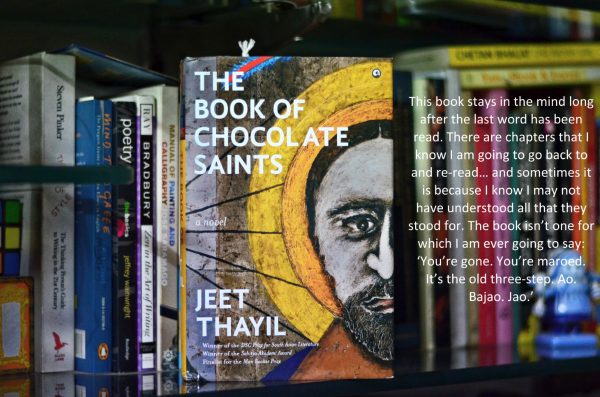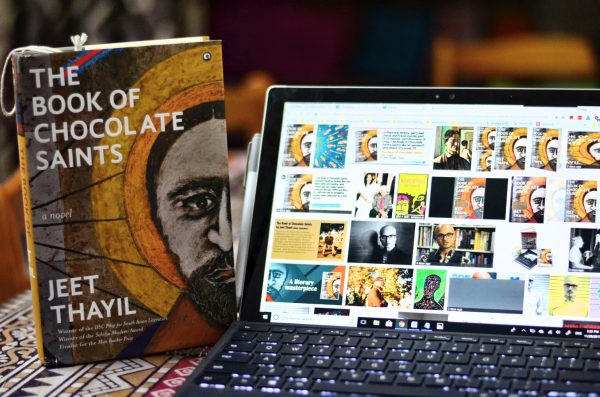Conversations around art
Review of ‘The Book of Chocolate Saints’ by Jeet Thayil
Jatin Das hasn’t probably read this book yet but what he said a couple of days back is relevant because he talks of the present having ‘no conversations around art. No one critiques it – there is no space to discuss art, even in publications. Even the government art institutions like NGMA, IGNCA and Lalit Kala academy have no synergy between them. It is sad.’ Though Jatin was focused on art as artists perceive it, the book that I am talking about weaves in writers, thinkers, poets, and of course, artists as they are all, as Jeet says, coming from the same poetry of ‘anarchy and anonymity’ and also because ‘poetry works in mysterious ways but it begins with verbal anarchy.’ ‘The Book of Chocolate Saints’ by Jeet Thayil easily picks up a reader from the creative inertia of the present and throws him right in the midst of the tumultuous cultural happenings in the India of the Seventies and the Eighties.
Now if you’re wondering why I used the word ‘tumultuous’ where softer definitions could have sufficed, let me just say that a book that has both restrained as well as not so undemonstrative references to the creative world then and where an artist or a poet or a writer is ‘falling into himself, through madness and folly into himself’ only that word fits snugly. What the poet and journalist Dismas Bambai only plans to do in the book is what the author picks up and does and this is nonly a part of the entire action. The book walks through incidents that clearly remind us of creative people like Dom Moraes, Francis Newton Souza, Namdeo Dhasal, Arun Kolatkar and plenty of others who make their appearance either as they are or were or in thinly veiled assumptions. And then there is the bilingual poet Narayan Doss who ‘knows it is audacious to have a name like Doss and want those things, to be so dark and want these things, to want what a Brahmin wants. He knows it is audacious, irresponsible, unrealistic; but this is what he wants and he wants it so badly it is a hole in the pit of his stomach.’ The narrative also brings in the painter and defunct poet Newton Francis Xavier whose life is what Dismas wants to portray in his second book.
The relationship between Dismas, the writer and Doss, the main character in his book leads us on to rather interesting revelations. And these are what creative artists in any period need to be wondering about. For instance, Dismas wonders about too little happening too late when he hears about a Swiss woman translating some of the poems penned by Doss. The questions are real and relevant for anyone at any point and this is what makes the book interesting to a reader who may not have a lasting interest in getting into the literary veins and arteries that anyway abound. At one point Dismas ponders: ‘How did the painter Xavier write two books of poems in such a prolific burst? How did these poems by a neophyte author become an international phenomenon and how did they make their author so much fame and money? Did no one notice that the friendship between Doss and Xavier resulted in oblivion for one and glory for the other?’ In fact, I have read the author’s own explanation of ‘the only poem that matters is the poem that picks up a gun’ and he says that ‘in 2017 in India, literature seems irrelevant. What difference can a poem make in the time of hate, when the criminals are in government and the lunatics are in charge of the asylum?’
I’d also say that the book is some kind of a literary thriller where connections with the relationships that existed between writers and artists of the seventies and the eighties can be traced if one wishes to. And if this is what tires a lay reader, he can always find joy in the mysteries of relationships that characters that are fictional are supposed to present. Jeet does this in a perfect way and as an added bonus, pours in questions that never lose their relevance as time passes. So this is one book that will bring joy to the academicians as well as those who are not well-versed with the literature and art references. By the way, there will also be a third set of readers who are forever looking for clues that will help them reach a conclusion, you know the Dan Brown sort of clues… well, go ahead and discover the real people whose lives and creations were influenced by writers like Baudelaire, James Joyce, Auden and the Hungryalists, and the Beat poets including Allen Ginsberg.
A part of me was certainly fascinated by the way Jeet transported my imagination to the way the artists, the poets, and the writers lived and conducted their affairs in those times and in places like Bombay, Bangalore, Goa, Paris, and New York. This works so well when transposed with our deepest desires that are perpetually driving in ‘a state of no mind, I thought, which she achieves by minimum use of the brake and horn. Instead of slowing down, she speeds into turns even with traffic approaching and then somehow she finds an opening and pushes the small car into it and out the other side.’ The novel is seductive, thrilling, and does not compromise with feelings that real people have.
These conversations on the anarchy and anonymity of creative output are subtly placed to surround the life and ambitions of Dismas who even gets under the skin of contemporary technology when he mentions that the ‘internet won’t always be confined to a screen. It will be everywhere, in the air, in water, grafted into our skins, which means after I die bits of me will be everywhere too, for ever everywhere.’ These are the kind of thoughts that pull the book from its meandering path in the past to all that is relevant to readers in the present.
This book stays in the mind long after the last word has been read. There are chapters that I know I am going to go back to and re-read… and sometimes it is because I know I may not have understood all that they stood for. The book isn’t one for which I am ever going to say: ‘You’re gone. You’re maroed. It’s the old three-step. Ao. Bajao. Jao.’
.
Details of the book:
Title: The Book of Chocolate Saints
Author: Jeet Thayil
Publisher: Aleph Book Company
ISBN: 978-93-86021-03-8
Price: Rs 799 (Hardback) (In 2017)
.
.
.
.
.
Arvind Passey
28 November 2017










